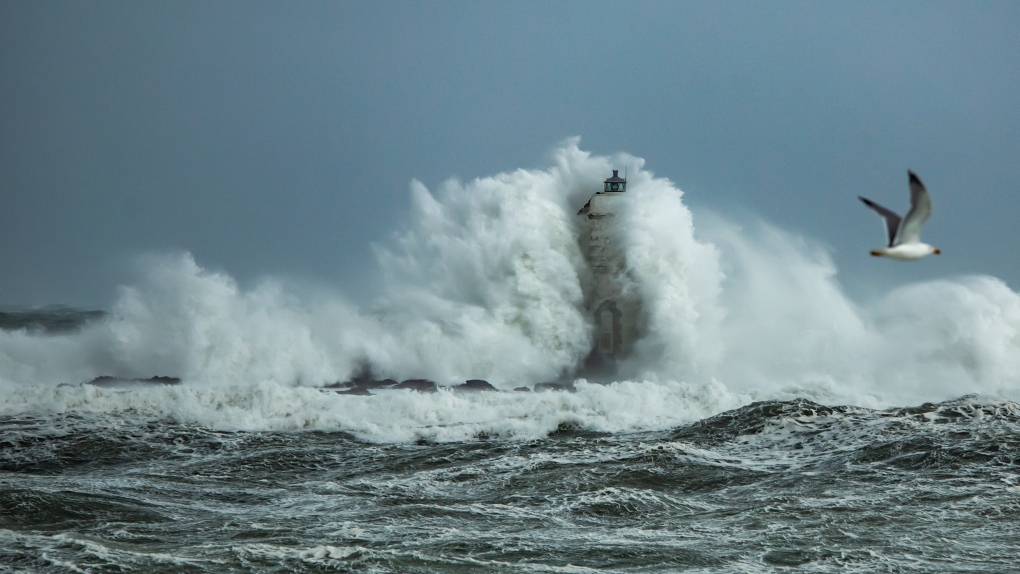B.C. oceanographer says AI formula can predict dangerous rogue waves
 A large wave strikes a lighthouse in Italy. (iStock)
A large wave strikes a lighthouse in Italy. (iStock)
Stories of unusually large ocean waves that seem to appear without warning have loomed large in marine folklore for centuries, killing sailors and confounding scientists who have tried to explain the phenomena known as "rogue waves."
But new research co-authored by a University of Victoria oceanographer claims to have developed a machine-learning model that can predict where and when these natural phenomena are likely to occur.
The researchers say the formula could save lives and protect the roughly 50,000 cargo ships that are sailing around the planet at any given time.
Rogue waves are elusive by nature, but are defined by deep troughs and steep walls that rise at least twice as high as any surrounding ocean wave.
"It used to be that people didn’t believe in them," says Johannes Gemmrich, a physical oceanographer at the University of Victoria and co-author of the study Machine-Guided Discovery of a Real-World Rogue Wave Model. "Sometimes ships just disappear and there's no one left there to tell the story."
That started to change in 1995, when a rogue wave 25 metres high was recorded at the Draupner gas platform in the Norwegian North Sea.
"That was the first time they could really measure them, but still it took a while to convince people that it wasn't a measurement error," Gemmrich says.
In the years that followed, two theories of rogue waves emerged. The first explanation says rogue waves are created when one wave slowly extracts energy from another, over time resulting in one very large wave. The second theory, known as "linear superposition," says that rogues waves are created when two or more wave systems briefly align in their troughs and crests, creating one extremely large wave.
Gemmrich believes that he and his collaborators at the University of Copenhagen have proven the latter theory is the most likely cause of rogue waves.
"If two wave systems meet at sea in a way that increases the chance to generate high crests followed by deep troughs, the risk of extremely large waves arises," writes University of Copenhagen co-author Dion Hafner. "This is knowledge that has been around for 300 years and which we are now supporting with data."
The data in the study was culled from 158 buoys dotting the world's oceans and collecting wave data 24 hours a day. The researchers estimate their data includes measurements of more than one billion waves.
"We registered 100,000 waves in our dataset that can be defined as rogue waves," Gemmrich says. "This is equivalent to around one monster wave occurring every day at any random location in the ocean."
Armed with that data, the researchers used artificial intelligence to comb through the oceanographic variables that correlate with the appearance of a rogue wave, eventually arriving at a kind of recipe for a monster wave to emerge.
The study authors are now focused on using their algorithm to predict where and when conditions for a rogue wave to emerge are highest.
Gemmrich says he will spend the next year applying the algorithm in the North Pacific Ocean off British Columbia, and hopes to be able to provide real-time rogue wave risk assessments to commercial shipping companies and other seafarers in their marine weather forecasts.
"The final outcome will be you get a forecast for the North Pacific and you see that wave height will be say six metres and a there's a really high probability of a rogue wave 12 metres high in two days," Gemmrich says.
"So if you want to ship something across the North Pacific and you see that the probability of a rogue is high off Alaska, you can take a more southern route."
CTVNews.ca Top Stories

BREAKING N.Y. prosecutors charge Luigi Mangione with murder of UnitedHealthcare CEO, court records show
Late Monday, Manhattan prosecutors filed murder and other charges against Luigi Nicholas Mangione in the killing of UnitedHealthcare's CEO, according to an online court docket.
Union dropped wage demand to 19% over four years in Canada Post negotiations: CUPW
The Canadian Union of Postal Workers (CUPW) has reportedly dropped its wage demand to 19 per cent over four years, CUPW negotiator Jim Gallant told CTV News.
Taxpayer-funded Eras Tour tickets returned by federal minister
While tens of thousands of fans packed Vancouver's BC Place for the last shows of Taylor Swift's Eras Tour this weekend, a federal cabinet minister wasn't one of them.
Sudbury, Ont., family traumatized after hospital said loved one had been released, when in fact they had passed away
Sudbury resident Angela Vitiello says a staff member at Health Sciences North told her that her brother, Allan St. Martin, was released from the hospital late last month when, in fact, he had passed away.
What the upcoming holiday GST relief will mean for consumers
The federal government's GST break will arrive this Saturday, just in time for the last stretch of holiday shopping.
Liberal government survives third Conservative non-confidence vote
Conservative Leader Pierre Poilievre's latest attempt to topple the minority Liberal government in a non-confidence vote failed on Monday, thanks to the New Democrats.
Katie Holmes refutes story about daughter Suri Cruise’s fortune
Katie Holmes has posted a screen grab of a Daily Mail article, which reported that her 18-year old daughter, whose father is Tom Cruise, is now a "millionaire."
Polygamous U.S. sect leader gets 50 years in prison in scheme to orchestrate sex involving children
A polygamist religious leader in the U.S. who claimed more than 20 spiritual “wives” including 10 underage girls was sentenced to 50 years in prison on Monday.
Trudeau says dealing with Trump will be 'a little more challenging' than last time
Prime Minister Justin Trudeau said dealing with incoming president Donald Trump and his thundering on trade will be 'a little more challenging' than the last time.

































